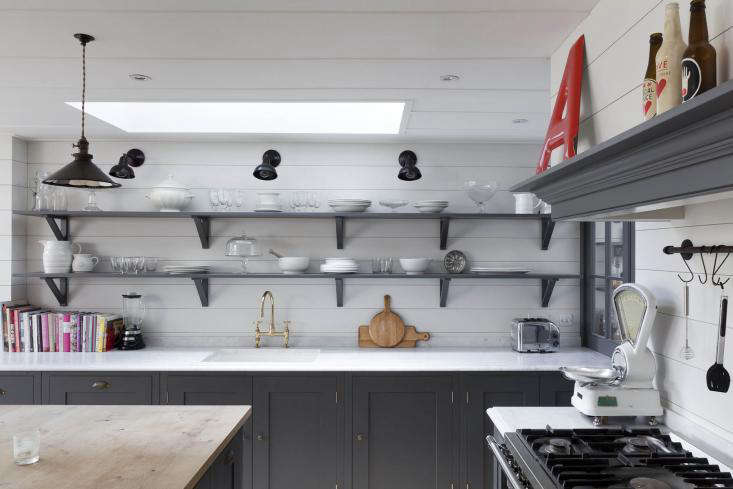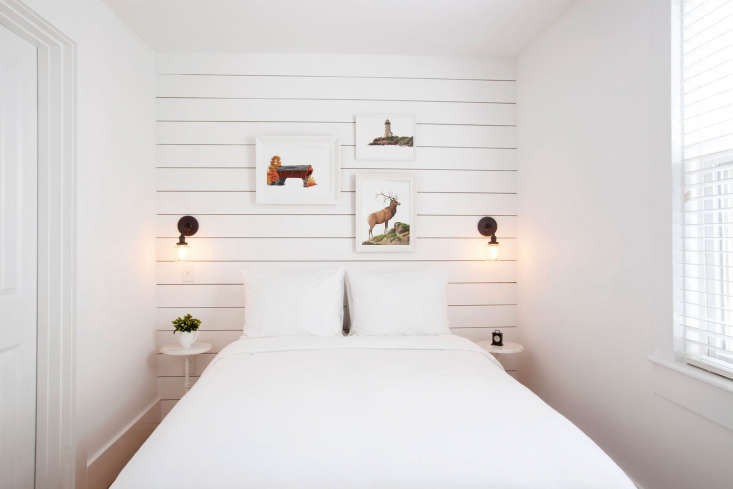Characterized by long horizontal (or vertical) panels formed by overlapping “rabbets” (grooved boards), weathertight shiplap has long been popular in areas with harsh climates. Because of this functionality and due to the fact that it was often made from relatively inexpensive pine, shiplap has traditionally been associated with less formal structures, such as woodland cabins and coastal cottages.
But architect Sheila Bonnell of FRAMe Architecture & Design (a member of the Remodelista Architect & Designer Directory) encourages us to break with tradition when it comes to shiplap, regarding it as not just a “rustic” or “period” material but also a timeless detail that is as much at home in modern architecture. Recently we asked Sheila to share her insights into the myriad applications of shiplap; here’s what she said.

Remodelista: You’ve used shiplap in many homes you’ve designed. What draws you to this material?
Sheila Bonnell: Put simply, shiplap is a less formal way of adding interest to a wall and/or dimension to a space. The fact that it has to be installed by hand and that you can feel the craftsmanship, the fact that it is a natural material, that it is textured, that it allows you to create a seamless line throughout a space, that it has historic and regional contexts—for me, all these things make shiplap very lively and engaging.

RM: Where do you use shiplap?
SB: Anywhere!
RM: Even in a formal house?
SB: Yes, if it feels right. I know it’s an anathema to some, but I tend to resist rules and a strict adherence to historic accuracy, which can become static, in favor of creating something that is affecting and engaging. So in a formal house I wouldn’t automatically rule shiplap out, because actually I think it’s really timeless. And because it creates texture in such a clean, unfussy way, it can work just as well in a contemporary setting. In fact, one of the things I love about shiplap is that it works both ways. Because it is handcrafted, it can add warmth to what might be a more austere modern setting. Or, conversely, because it has a very clean line, particularly when painted, it can be used to make a historical setting feel more contemporary.

RM: How do you use shiplap in a space?
SB: Shiplap is extremely versatile so it can be used in a number of different ways, depending on the needs of the space. At Harbor Cottage, the first floor was a single, open room which served as a living room, dining area, and kitchen. To unify the space, I used shiplap on all four walls, as well as across the doors and kitchen cabinets.
You can take this continuity further by also using shiplap in the ceiling. Or you can use shiplap to accentuate a single architectural feature. In my own home, covering all the walls was beyond our budget, so we made the choice to panel the high ceilings as a means a maintaining the intimacy of the space.
Shiplap can also be used to create a nice sense of scale. For example, if you have a lofty ceiling, you might use shiplap only up to a particular height on the wall, to create more human scale as well as a secondary datum, which is architecturally more interesting.

RM: Painted or unfinished? What kind of wood do you typically use?
SB: Again, it depends on the space and what you are trying to achieve. In one of the first projects I did, which was a small cabin in Maine, I used Point Orford Cedar, that I left unfinished. Not only was the texture of the wood plainly visible but also the boards responded to the weather, releasing an amazing aroma, all of which enhanced the feeling of the wood as a living thing.
In my own home, we used poplar and then whitewashed it, so that some of the grain came through. And then at Harbor Cottage we used poplar again and painted it Linen White from Benjamin Moore. Poplar is great if you are going to apply a finish, because it is smooth and accepts paint evenly. One thing about paint though, you want to make sure that you maintain the space in between the boards, so apply paint carefully, or preferably, paint the boards before you install them.

RM: I’ve seen the boards applied right up against each other and with a more of a gap. What’s your preference?
SB: Myself, I like to maintain a bit of a channel between the boards, rather than have them right up against each other. This creates a lighter, more airy feel and emphasizes the wonderful horizontal (or vertical) accent of the boards.

RM: Any other tips for applying shiplap?
SB: Yes. Most importantly, make sure you maintain a seamless line across your architectural features! At Harbor Cottage [shown] you can see that the lines are carried right through the door and along the kitchen cabinets. This kind of attention to detail demonstrates intentionality, so that even though the effect of shiplap is less formal, it still shows that someone really thought about it what they were doing and put a lot of care into the space.

Curious about the difference between shiplap, V-groove, and beadboard? Wonder no more: See our post Remodeling 101: The Ultimate Wood Paneling Guide with Jersey Ice Cream Co.
For more of our favorite shiplap-clad rooms, check out:
- Kitchen of the Week: A Streamlined Cape Cod Classic
- The Soulful Side of Old Cape Cod: Justine’s Family Cottage
- Kitchen of the Week: A Proper English Kitchen with New England–Inspired Shiplap Paneling
N.B.: This post is an update; the original story ran on July 20, 2016.




Have a Question or Comment About This Post?
Join the conversation (15)